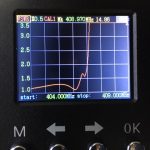Vergleich: AAI N1201SA Vector Impedance Analyzer 137,5 – 2700MHz
Wie versprochen folgen nun 2 Vergleichstests mit einem Agilent Netzwerkanalayser und dem N1201SA.
Im QRL hatte ich Duplexer zum Abgleich und habe den N1201SA mit einem Agilent SP8714 ET Netzwerk Analyser in der SWR Messung verglichen.
(Ein Klick auf das jeweilige Bild öffnet es vergrößert)
Die Messungen sind exakt identisch. Das Gerät ist eine echte Empfehlung, denn es ist eben mal in der Hemdtasche mitgenommen und für eine erste Fehleranalyse ist es mehr als ausreichend, bevor man einen Messplatz bemüht.
VY 73 de Hans-Jürgen Marx DJ3LE








I agree the N1201SA is great value. One thing I did notice the output power is not +10dbm, more like -10dbm, but does not appear to affect the operation.
73’s
Simon ZL2BRG
Dear Simon,
thank you for the comment. The output of my N1201SA is about -13dBm. For quick results it’s ok and exact.
Best 73’s de Hans, DJ3LE
Interesting review, missing investigation how the output spectrum looks.
Looking at the range I very much believe the N1201SA is build around the ADF4350/4351 synthesizer chip. The Main range of the chip is 2200 to 4400MHz and the lower bands are by deviding :2. As a result all frequencies are near square waves. This chip outputs near 0dBm. Between the synthesizer and the output connector must be something like this reflection-bridge ( https://www.ebay.com/itm/RF-bridge-0-5-3000-MHz-VNA-Return-Loss-VSWR-SWR-reflection-bridge-antenna/332052527822 ) The loss between the synthesiser and the DUT output is about 6dB. That explains partially the low output.
Third harmonics (all uneven) are always strong, so probably they included some sort of selectable low pass filter?
With a square wave i do not expect you can measure reflections better than about -10dB to -15dB which would mean a VSWR of 1.5:1 at best.
So i very much like to know how the frequency spectrum looks on a spectrum analyser. How low (in dB) are the harmonics compared to the fundamental frequency and is there maybe a selectable low-pass filters inside?